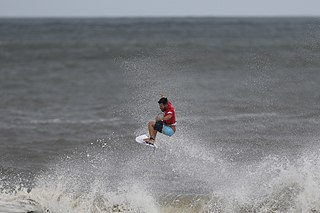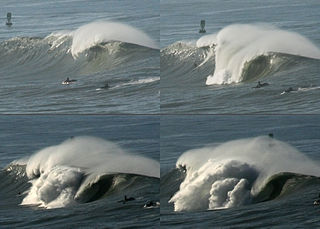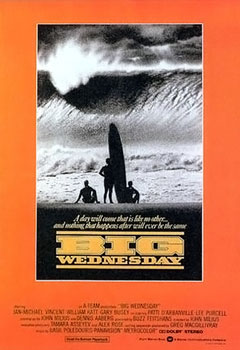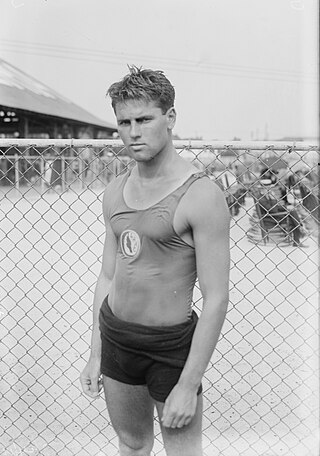Related Research Articles

Surfing is a surface water sport in which an individual, a surfer, uses a board to ride on the forward section, or face, of a moving wave of water, which usually carries the surfer towards the shore. Waves suitable for surfing are primarily found on ocean shores, but can also be found as standing waves in the open ocean, in lakes, in rivers in the form of a tidal bore, or wave pools.

A surfboard is a narrow plank used in surfing. Surfboards are relatively light, but are strong enough to support an individual standing on them while riding an ocean wave. They were invented in ancient Hawaii, where they were known as papa he'e nalu in the Hawaiian language, and were usually made of wood from local trees, such as koa. They were often over 460 cm (15 ft) in length and extremely heavy. Major advances over the years include the addition of one or more fins (skegs) on the bottom rear of the board to improve directional stability, and numerous improvements in materials and shape.

Mavericks is a surfing location in northern California outside Pillar Point Harbor, just north of the town of Half Moon Bay at the village of Princeton-by-the-Sea. After a strong winter storm in the northern Pacific Ocean, waves can routinely crest at over 25 ft (8 m) and top out at over 60 ft (18 m). Routinely, waves that break can be recorded on seismometers. The break is caused by an unusually shaped underwater rock formation.

Laird John Hamilton is an American big-wave surfer, co-inventor of tow-in surfing, and an occasional fashion and action-sports model and actor. He is married to Gabrielle Reece, a former professional volleyball player, television personality, and model.
Mark Sheldon Foo was a professional surfer who favored big wave surfing. Foo drowned while surfing at Mavericks, Half Moon Bay, California, in 1994.

A leg rope or surfboard leash is a urethane cord attached to the deck of a surfboard, down near the tail. It prevents the surfboard from being swept away by waves and stops runaway surfboards from hitting other surfers and swimmers. Modern leashes consist of a urethane cord where one end has a band with a velcro strap attached to the surfer's trailing foot, and the opposite has a velcro strap attached to the tail end of the surfboard. Should the surfer fall while riding a wave, the surfboard will not be swept away, thus allowing the surfer to quickly recover his surfboard and return to the take-off zone.

Big Wednesday is a 1978 American coming of age buddy sports comedy-drama film directed by John Milius. Written by Milius and Dennis Aaberg, it is loosely based on their own experiences at Malibu, California. The picture stars Jan-Michael Vincent, William Katt, and Gary Busey as California surfers facing life and the Vietnam War against the backdrop of their love of surfing.
Greg Noll was an American pioneer of big wave surfing and a prominent longboard shaper. Nicknamed "Da Bull" by Phil Edwards in reference to his physique and way of charging down the face of a wave, he was on the U.S. lifeguard team that introduced Malibu boards to Australia around the time of the 1956 Summer Olympics in Melbourne. He produced a "legendary" series of five Search for Surf films.

The riding of waves has likely existed since humans began swimming in the ocean. In this sense, bodysurfing is the oldest type of wave-catching. Undoubtedly ancient sailors learned how to ride wave energy on many styles of early boats. Archaeological evidence even suggests that ancient cultures of Peru surfed on reed watercraft for fishing and recreation up to five thousand years ago. However, standing up on what is now called a surfboard is a relatively recent innovation developed by the Polynesians. The influences for modern surfing can be directly traced to the surfers of pre-contact Hawaii.

Lake surfing is surfing on any lake with sufficient surface area for wind to produce waves. As with ocean surfing, ideal wave conditions are when the wind switches offshore. However, when this occurs over a lake the waves generated by previous onshore wind subside relatively quickly. This means lake surfers have a shorter window of opportunity to surf ideal waves. Lake surfers are often out during and experiencing the same storm that creates the waves whereas ocean surfers are more often surfing on swell produced by storms hundreds of miles away and that may have taken days to reach shore. In addition to making it more difficult to manage surfboards, high winds can make the face of a wave and water surface rough. Increased wave frequency due to shorter fetch results in less rest between waves and sets of waves. This can make it necessary to paddle out through waves because there may not be a long enough pause between sets to paddle out between them.

Miklos Sandor Dora III, known professionally as Miki Dora, was a noted surfer of the 1950s and 1960s in Malibu, California.

Highwater is a 2008 documentary film centered on surfing's Triple Crown competitions, the professional surfing tour's final three competitions held each year on the North Shore of Oahu. The film is directed by Dana Brown, son of famed surfer and filmmaker Bruce Brown.
Christiaan "Otter" Bailey, is an American professional surfer, known for his experience as a surf safari guide and skill as a big wave surfer and skateboarder.

Thomas Edward Blake was an American athlete, inventor, and writer, widely considered to be one of the most influential surfers in history, and a key figure in transforming surfing from a regional Hawaiian specialty to a nationally popular sport. Assessing Blake's significance, sociologist Kristin Lawler wrote that

Ricochet was a female Golden Retriever dog from San Diego. She was one of the original surfing dogs that started the whole dog surfing circuit. She entered her first surf dog competition when she was 15 months old. She was a competitive surfing dog for several years and typically placed in one of the top three spots of competitions.

Allen Sarlo is an American surfer, most prominently known as one of the original members of the Z-Boys surf and skateboarding team. Surfing Magazine recognized him as the first to "kill" a wave. The aggressive and slashing style of surfing he pioneered during the 1970's earned him the nickname "Wave Killer". He is considered by many as "The King of Malibu".
The Lost Wave: An African Surf Story is a 2007 São Tomé and Príncipe documentary film directed by Sam George.

The Malibu Historic District is a 160-acre (65 ha) area that was listed on the National Register of Historic Places listings in Los Angeles County, California on January 29, 2018. The approximate area of the district is along the Pacific Coast Highway from east of the Malibu Pier to the Malibu Colony privacy fence. Malibu was ground zero for California's surf culture, and was designated the first World Surfing Reserve by the Save the Whales Coalition in 2010. For its role in the cultural popularity of the surfing sport, and its subsequent technological influence on the surfboard evolution and efficiency, the period of the NRHP designation significance is 1945–1959.

Para surfing or adaptive surfing is a form of surfing in which a disabled individual uses a board or waveski to ride on a breaking wave. Competitively, the International Surfing Association (ISA) has hosted the World Para Surfing Championships annually since 2015. In addition, the Association of Adaptive Surfing Professionals (AASP) was formed in 2022 as the international governing body of professional adaptive surfing, and administers the AASP World Tour including events in Hawaii and California for its inaugural year. The Para Surf League (PSL), launched in 2022, organizes amateur and professional contests worldwide.
References
- ↑ National Spinal Cord Injury Association
- ↑ "Life Rolls On". Life Rolls On. Retrieved 2024-10-26.